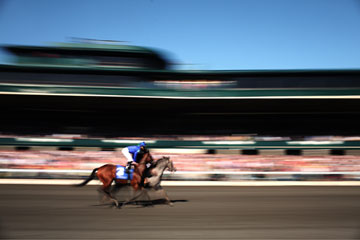
At Keeneland, a premier track in Lexington, Ky., the stakes can run to $750,000.
(3 of 5)
There is a great temptation to help these quick but too-often-fragile horses earn their needed wins by dosing them with steroids, painkillers, diuretics and other drugs. But doping can endanger the animals by enabling them to run while injured--too often with fatal results. In a string of outstanding articles published in recent years, racing writer Joe Drape and others at the New York Times have documented the unsafe and inhumane underbelly of American racing. Summarizing one investigation last year, for example, the newspaper reported: "A computer analysis of data from more than 150,000 races, along with injury reports, drug test results and interviews, shows an industry still mired in a culture of drugs and lax regulation and a fatal breakdown rate that remains far worse than in most of the world." There is something wrong in a sport that kills two dozen of its athletes every week, as horse racing does.
Elsewhere in the world, Thoroughbred racing is doing just fine without resorting to drugs. From Ireland to Australia, from the clamor of Hong Kong to the Downs of England, strong governing authorities enforce strict regulations. Just last month, a prominent trainer was found secretly doping horses. He was immediately fired by the Emir and banned from British racing for a ruinous eight years. In some U.S. jurisdictions, fines for doping are actually smaller than the purses won by the cheating stables.
Death came even to the hallowed Derby in 2008. The filly Eight Belles broke down after finishing second in the race and had to be euthanized. After that, industry leaders launched a campaign to purge the sport of drugs. But the crazy quilt of state legislatures and state racing commissions that set racing rules has so far failed to come up with a uniform code. (In a promising development, the Mid-Atlantic states recently came to agreement on a tough new code, which the Jockey Club's chief, James Gagliano, hopes will be a national model.)
Pressures in the breeding business are compounded by decisions made at the tracks. For years, many of these operations have watched their attendance drop as their fan base ages. According to one study, the sport is losing 4% of its fans every year. Such storied venues as Florida's Hialeah Park, California's Bay Meadows and New Jersey's Garden State Park have been forced to close over the past dozen years. In Los Angeles, Hollywood Park--which counted among its original shareholders Walt Disney, Bing Crosby, Sam Goldwyn and Joan Blondell--may be running its last races this year.
To survive, many tracks have added slot machines, video lottery terminals and even casino table games to create what are known in the industry as racinos. The hope was that money from more popular games could be used to create bigger purses, which would spur greater excitement around horse racing and thus attract new fans. But it hasn't always worked that way. The fan base for racing continues to erode, while bigger purses, perversely, heighten the incentives to cheat.
Further, the racino solution is in many respects a surrender pact. It says, essentially, that racing can no longer stand on its own four feet and must be propped up by other revenue. At some of the most lucrative racinos, the horses are practically an afterthought--albeit a very expensive one.
